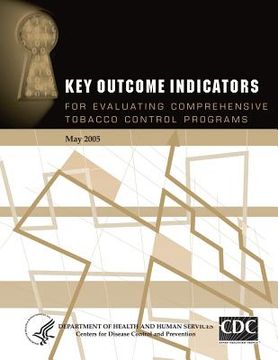Key Outcome Indicators for Evaluating Comprehensive Tobacco Control Programs (en Inglés)
Reseña del libro "Key Outcome Indicators for Evaluating Comprehensive Tobacco Control Programs (en Inglés)"
If the United States were to meet the Healthy People 2010 goal of reducing smoking prevalence to 12% among adults and 16% among young people aged 14 through 17 years, more than 7 million premature deaths after 2010 could be prevented. Studies show that investing in state tobacco control programs and implementing effective tobacco control policies significantly reduces cigarette consumption and improves health outcomes. To continue funding state programs, however, legislators, policy makers, and other funders of state programs want to see evidence that the program is effective and that resources are being used wisely. To produce such evidence, state tobacco control programs must evaluate their programs. Good evaluation is the key to persuading policy makers that your program is producing results that will lead to improved health for the community. If good evaluation is key to proving that your program is effective, then selecting the right indicators to measure is key to a good evaluation. That's where this book will help. This publication is a companion to the 2001 publication Introduction to Program Evaluation for Comprehensive Tobacco Control Programs, which is based on the Centers for Disease Control and Prevention's (CDC's) Framework for Program Evaluation. In Introduction to Program Evaluation for Comprehensive Tobacco Control Programs, we discuss in detail the six steps of a good evaluation as they apply to tobacco prevention and control programs: 1. Engage stakeholders. 2. Describe the program. 3. Focus the evaluation. 4. Gather credible evidence. 5. Justify your conclusions. 6. Ensure evaluation findings are used and share lessons learned. This new publication provides information on selecting indicators and linking them to outcomes. In Introduction to Program Evaluation for Comprehensive Tobacco Control Programs, we described how to select indicators to measure program outcomes. We also gave examples of indicators and suggested sources of data on those indicators. This publication goes further. Here we discuss in detail 120 evidence-based key indicators that have been scientifically linked to program outcomes. We also document the evidence that shows the value of using these indicators to measure the progress of a state tobacco control program. To help you make informed choices about which indicators are most suitable for your program, we engaged a panel of experts in the field of tobacco control to rate each indicator on various criteria, including overall quality, resources needed, strength of evaluation evidence, utility, accepted practice, and face validity to policy makers. The ratings will help the reader decide, for example, which indicators can be measured within budget or which indicators are likely to carry the most weight with policy makers. In essence, this publication is a consumer's guide to tobacco control indicators for program managers and evaluators. In this publication we provide examples of data sources and survey questions that evaluators can use to gather data from their programs' target populations. We were particularly careful about our choice of example data sources and survey questions. Most come from commonly used state and national surveys and surveillance systems, and using them will allow managers and evaluators to compare their findings with data from other states and over time.

